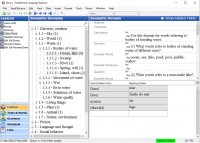I wonder what the differences between a thesaurus and a mind-map (or semantic tree) are. 
You are using an out of date browser. It may not display this or other websites correctly.
You should upgrade or use an alternative browser.
You should upgrade or use an alternative browser.
Mind-map learning strategy
- Thread starter phz
- Start date
Shun
状元
Good thought. With a semantic tree, you work with distinctions between words more, and you can have deeply nested subcategories. The subcategories can also contain information on the usage of words; for example, you can make a distinction that some words can't be used with people or can only be used with people. At the very lowest subcategory, you could also add frequent collocations or, for Chinese, the coverbs, or add example sentences for a single word. So you are much freer to add relevant information and represent it sensibly. There isn't enough room for such information in a thesaurus, where you just have about 10-20,000 categories of words, with 10-50 words each.
It is of course much less complex to compose a thesaurus than a semantic tree. But it would surely be great to have a good semantic tree.
It is of course much less complex to compose a thesaurus than a semantic tree. But it would surely be great to have a good semantic tree.
Last edited:
Good afternoon Shun,
I'm attaching a .zip file with a few documents I downloaded some time ago from http://rapidwords.net/resources in case you want to just have a look at them.
It contains the following documents:
Chinese.docx
Domain Hierarchy (English).docx
Domain Outline (English)_0.docx
English (specific first) (A4).docx
English_0.docx
I'm also attaching a photo from https://software.sil.org/fieldworks/resources/tutorial/lexicon/semantic-domains/
Have a nice weekend!
I'm attaching a .zip file with a few documents I downloaded some time ago from http://rapidwords.net/resources in case you want to just have a look at them.
It contains the following documents:
Chinese.docx
Domain Hierarchy (English).docx
Domain Outline (English)_0.docx
English (specific first) (A4).docx
English_0.docx
I'm also attaching a photo from https://software.sil.org/fieldworks/resources/tutorial/lexicon/semantic-domains/
Have a nice weekend!
Attachments
Shun
状元
Good afternoon Sobriaebritas, (it's still 10:45 AM here, sometimes I wrote at night)
this is truly excellent material, even in Chinese, thank you! It forms an excellent basis for a Chinese semantic tree. You must be quite an expert. I can basically discard what I've done so far and start with your semantic categories. If I consider it a hobby activity and stay with it, maybe in 3 years I will have something presentable.
Have a nice weekend, too,
Shun
this is truly excellent material, even in Chinese, thank you! It forms an excellent basis for a Chinese semantic tree. You must be quite an expert. I can basically discard what I've done so far and start with your semantic categories. If I consider it a hobby activity and stay with it, maybe in 3 years I will have something presentable.
Have a nice weekend, too,
Shun
Hello Shun,
I'm glad you find it useful!
You flatter me. I'm just a humble 外国专家 who studies Chinese as a hobby.
I'm glad you find it useful!
You must be quite an expert
You flatter me. I'm just a humble 外国专家 who studies Chinese as a hobby.
Shun
状元
Hi sobriaebritas,
I do!
I see, an expert nevertheless, albeit a humble one.
I'm glad you find it useful!
I do!
You flatter me. I'm just a humble 外国专家 who studies Chinese as a hobby.
I see, an expert nevertheless, albeit a humble one.

